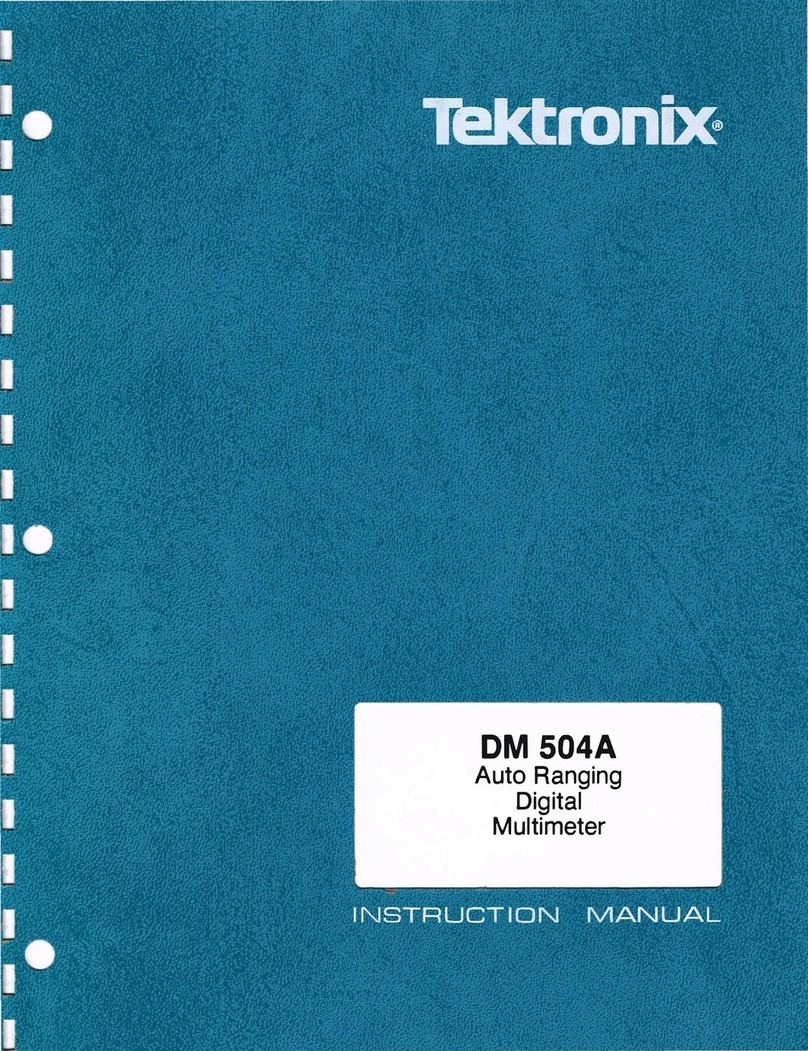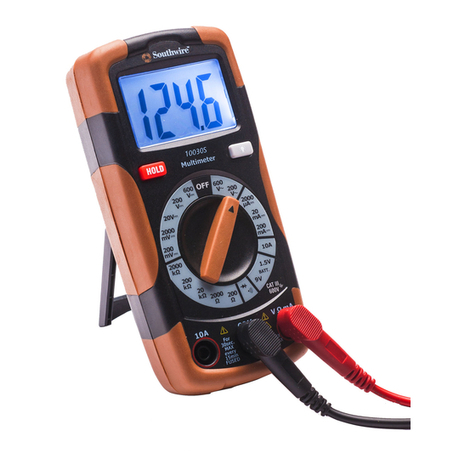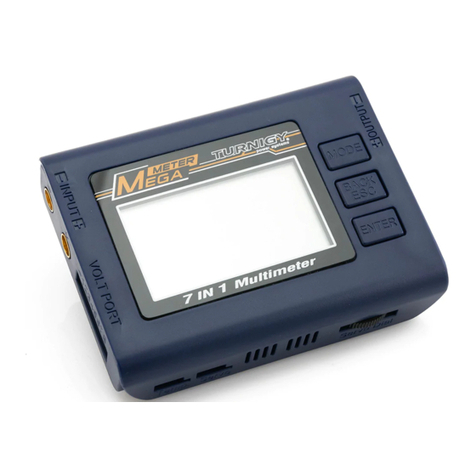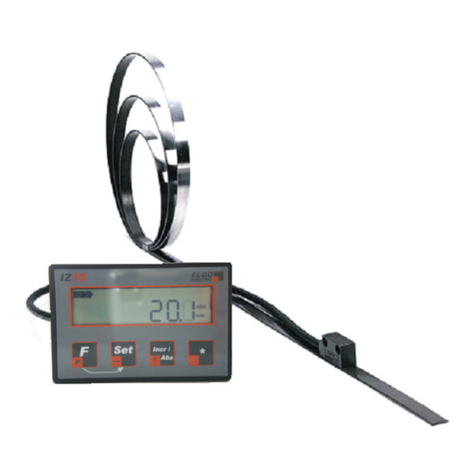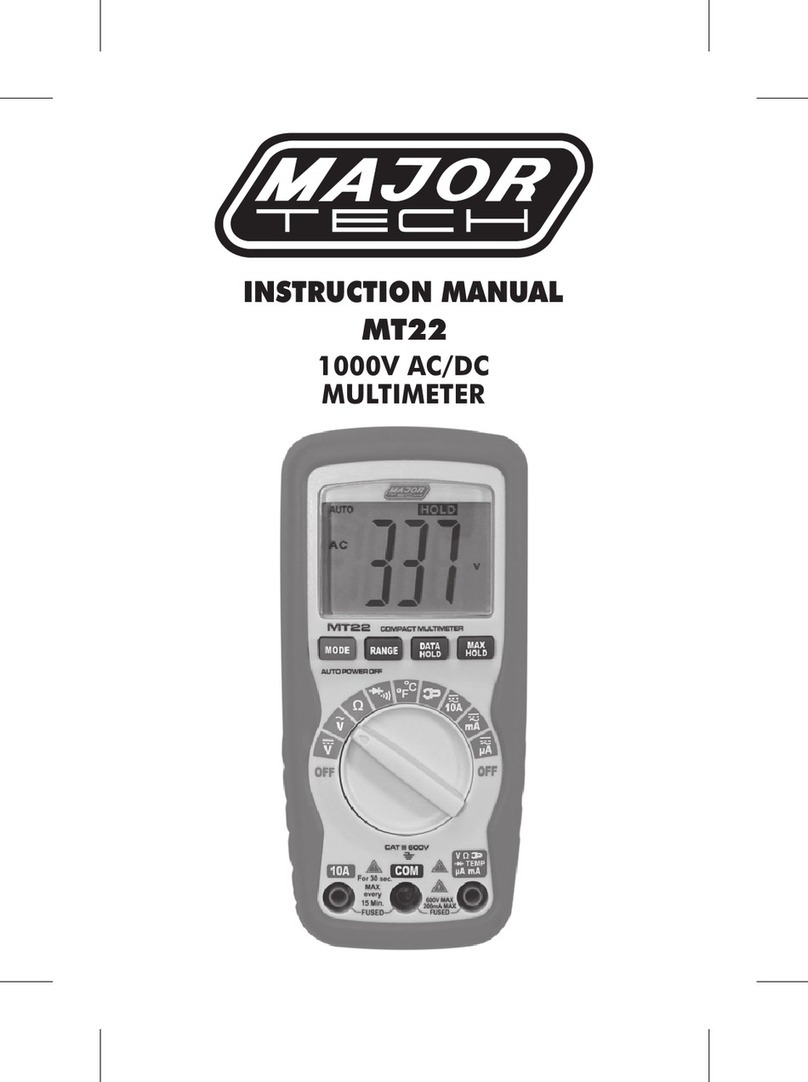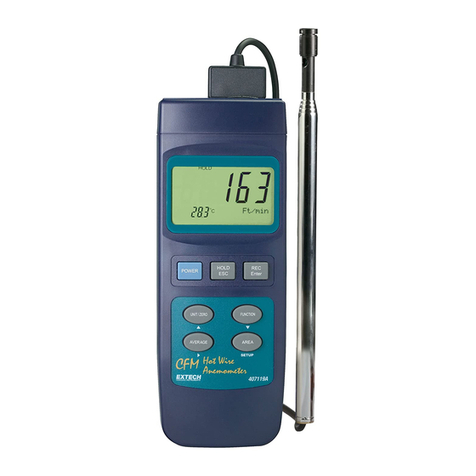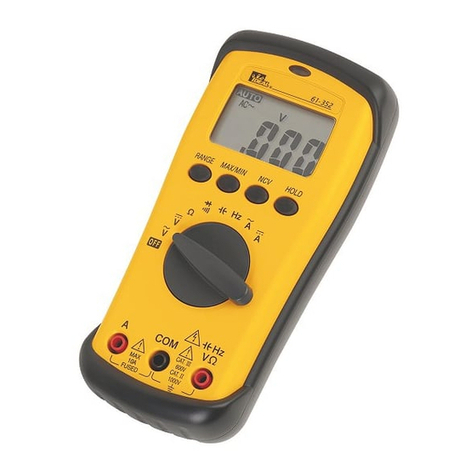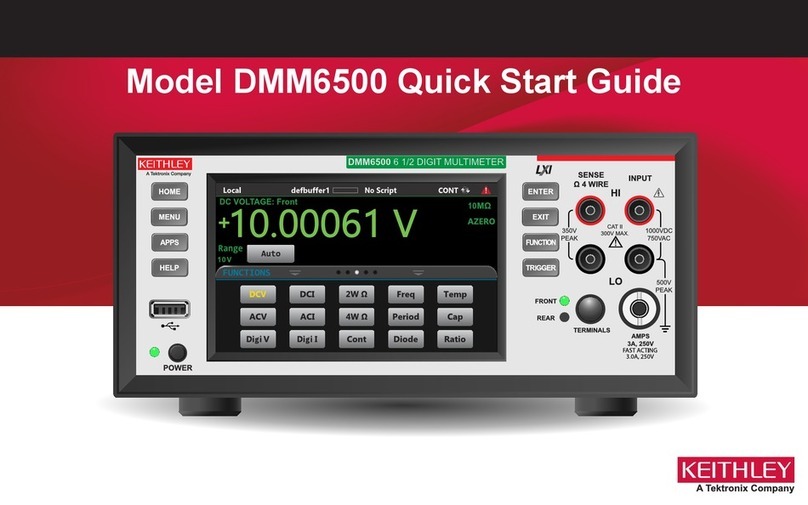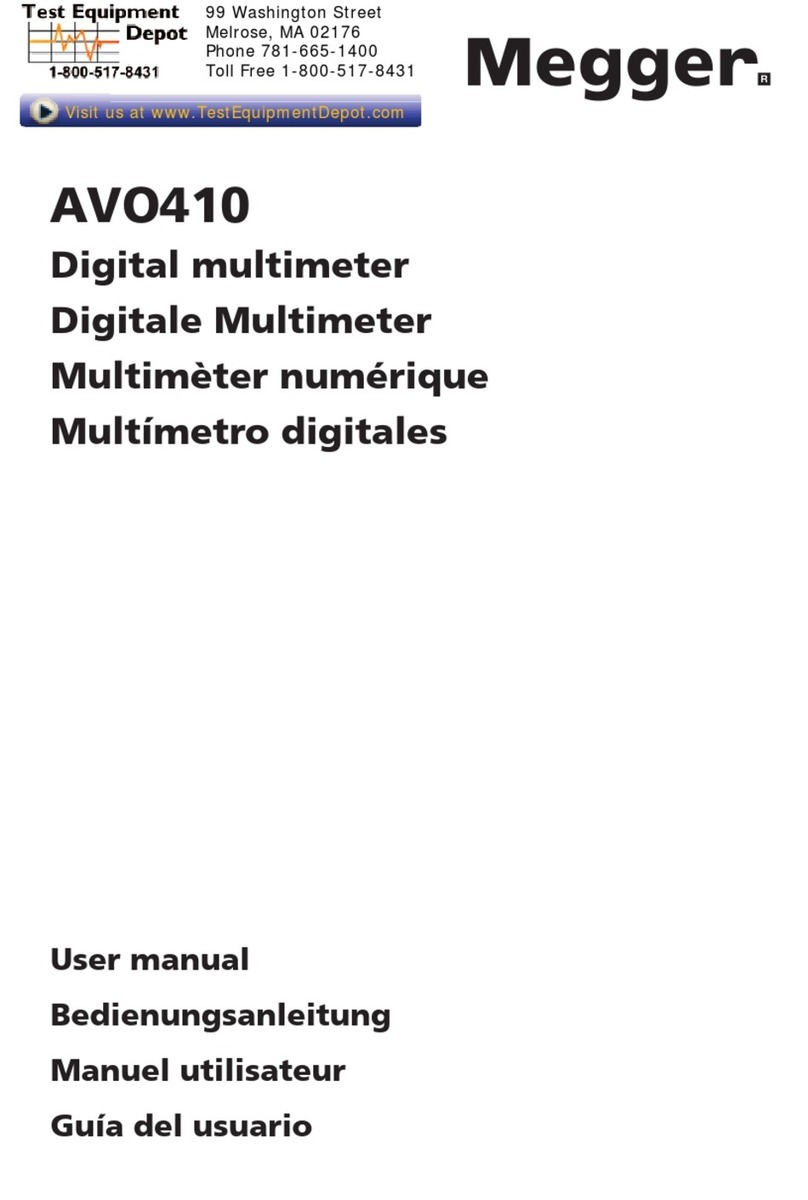Power Fist 8347676 User manual

User Manual
8347676V 2.0 Digital
Multimeter
Please read and understand all instructions before use.
Retain this manual for future reference.


3
For technical questions call: 1-800-665-8685
V 2.0 8347676
Digital
Multimeter
SPECIFICATIONS
DC Voltage Range 200m/2,000m/20/200/250V
AC Voltage Range 200/250V
DC Current Range 200µA/2000µA/20mA/200mA
AC Current Range No
Resistance 200/2,000/20k/200k/2,000k/20M Ω
Diode Test 2.8V/1mA
Continuity Yes
Decibels No
LIQUID CRYSTAL DISPLAY (LCD)
Display 3-1/2 digit LCD with max reading of 1999
Low Battery Indication shown on LCD
Negative Polarity Indication shown on LCD
Overrange Indication 1 shown on the LCD
DEVICE
CAT Rating CAT II 250V
Automatic Power Off No
Data Hold Function No
Battery Test No
Range Selection Manual
Number of Functions 6
Number of Ranges 19
Sampling Rate Approx. 3 times/sec.
Battery Details 1 x 9V battery, 6F22 or equivalent
Fuse Yes
Operation Temperature 0°C ~ 40°C, < 75%RH (Relative Humidity)
Storage Temperature -10°C ~ 50°C, < 85%RH (Relative Humidity)
Dimensions 128 x 66 x 26 mm
Weight .5 lbs (130g) including battery

Digital Multimeter
4For technical questions call: 1-800-665-8685
8347676V 2.0
ELECTRICAL SYMBOLS
Alternating Current
Direct Current
Caution, risk of danger, refer to the operating manual before use.
Caution, risk of electric shock.
Earth (ground) Terminal
Fuse
Conforms to European Union directives
The equipment is protected throughout by double insulation or reinforced insulation.
This product has been to tested to the requirements of CAN/CSA-C22.2 NO. 61010-1, second edition,
including Amendment 1, or a later version of the same standard incorporating the same level of
testing requirements.
INTRODUCTION
This meter is a compact 3 1/2–digit digital multimeter for measuring DC and AC voltage, DC current, Resistance,
Diode and Continuity.
SAFETY
The multimeter has been designed according to IEC-61010 concerning electronic measuring instruments with a
measurement category (CAT II 250V) and Pollution degree 2.
IMPORTANT SAFETY PRECAUTIONS
WARNING! Read and understand all instructions before using this tool. The operator must follow basic
precautions to reduce the risk of personal injury and/or damage to the equipment. Before allowing someone
else to use this tool, make sure they are aware of all safety information.
WARNING! The warnings, cautions and instructions discussed in this instruction manual cannot cover all
possible conditions and situations that may occur. common sense and caution are factors that cannot be built
into this product, but must be supplied by the operator.
NOTE: Keep this manual for safety warnings, precautions, operating, inspection and maintenance instructions.
WORK AREA
1. Operate in a safe work environment. Keep your work area clean and well lit.
2. Do not use in the presence of flammable gases or liquids.
3. Keep anyone not wearing the appropriate safety equipment away from the work area.
4. Minimize distractions in the work environment. Distractions can cause you to lose control of the tool.
5. Store tools properly in a safe and dry location to prevent rust or damage.
6. Always lock up tools and keep them out of the reach of children.

Digital Multimeter
5
For technical questions call: 1-800-665-8685
8347676 V 2.0
PERSONAL SAFETY
CAUTION! Wear protective equipment approved by the Canadian Standards Association (CSA) or American
National Standards Institute (ANSI) when using the tool.
1. Head Protection
a. Always wear impact safety goggles that provide front and side protection for the eyes.
b. Wear the appropriate rated dust mask or respirator when working around metal, wood and chemical
dusts or mists.
c. Wear earplugs if the power tool or work environment is noisy.
d. Wear a full-face shield if your work creates metal filings or wood chips.
e. Wear a hard hat to protect your head from falling objects.
2. Gloves
a. The gloves should provide protection based on the work materials.
b. Wear suitable gloves to reduce the effects of vibration.
3. Protective Clothing
a. Wear protective clothing designed for the work environment and tool. Examples are electrical non-
conductive clothes or clothes treated to resist corrosive liquids or materials.
4. Foot Protection
a. Steel toe footwear or steel toe caps to prevent injury from falling objects.
b. Non-skid footwear is recommended to maintain footing and balance.
5. Control the tool, personal movement and the work environment to avoid personal injury or damage to tool.
Stay alert, watch what you are doing and use your common sense.
a. Keep articles of clothing, jewelry, hair, etc., away from moving parts to avoid entanglement with a tool.
b. Do not operate any machine/tool when tired or under the influence of drugs, alcohol or medications.
c. Do not overreach when operating a tool. Proper footing and balance enables better control of a tool in
unexpected situations.
SPECIFIC SAFETY PRECAUTIONS
WARNING! Use caution when working above 30V AC rms, 42V peak, or 60V DC. Such voltages pose a
shock hazard.
To avoid possible electric shock or personal injury, follow these guidelines:
1. Do not use the meter if it is damaged. Before you use the meter, inspect the case. Pay particular attention to
the insulation surrounding the connectors.
2. Inspect the test leads for damaged insulation or exposed metal. Check the test leads for continuity. Replace
damaged test leads before you use the meter.
3. Do not use the meter if it malfunctions. Protective features may be impaired. When in doubt, have the
meter serviced.
4. Do not operate the meter around explosive gas, vapor, or dust as an electric spark may cause the gas vapour
or dust to ignite.
5. Do not apply more than the rated voltage, as marked on the meter, between terminals or between any
terminal and earth ground.
6. When measuring current, turn off power to the circuit before connecting the meter. Remember to place the
meter in series with the circuit.
7. When using the probes, keep your fingers behind the finger guards on the probes.
8. Remove the test leads from the meter before you open the battery cover or the case.
9. Do not operate the meter with the battery cover or portions of the case removed or loosened.
10. To avoid false readings, which could lead to possible electric shock or personal injury, replace the battery as
soon as the low battery indicator appears.

Digital Multimeter
6For technical questions call: 1-800-665-8685
8347676V 2.0
11. To avoid electric shock, do not touch any naked conductor with your hand or skin. Do not ground
yourself while using the meter.
12. Be aware that an input jack connected to a powered circuit may also create potential current at all other
input jacks.
13. CAT II - Measurement Category II is for measurements performed on circuits directly connected to low
voltage installation. (Examples are measurements on household appliances, portable tools and similar
equipment). Do not use the meter for measurements within Measurement Categories III and IV.
TOOL USE AND CARE
1. Use the correct tool for the job. Do not force a tool or attachment to do the work of a larger industrial tool.
Maximize tool performance and safety by using the tool for its intended task.
2. This tool was designed for a specific function. Do not modify or alter this tool or use it for an
unintended purpose.
3. Securely hold this tool using both hands, unless it is designed for single hand use. Using a tool with only
one hand can result in loss of control.
4. Maintain tools with care (see Maintenance).
UNPACKING
1. Carefully remove the parts and accessories from the box. Retain packaging material until you have carefully
inspected and satisfactorily installed or operated the tool.
2. Make sure that all items in the parts list are included.
3. Inspect the parts carefully to make sure the tools and accessories were not damaged while shipping.
WARNING! Do not operate the tool if any part is missing. Replace the missing part before operating. Failure to
do so could result in a malfunction and serious personal injury.
PARTS IDENTIFICATION
Contents:
• Digital Multimeter
• Test Lead Black (negative)
• Test Lead Red (positive)
ASSEMBLY
NOTE: When this manual refers to a part number, it refers to the included parts list.
The multimeter comes preassembled. The two test leads are plugged into the appropriate jack based on the
function chosen.

Digital Multimeter
7
For technical questions call: 1-800-665-8685
8347676 V 2.0
OPERATION
CAUTION! To avoid possible damage to the meter or to the equipment under test, follow these guidelines:
1. Disconnect circuit power and discharge all capacitors before testing resistance, diode or continuity.
2. Use the proper terminals, function and range for your measurements.
3. Before measuring current, check the meter’s fuse and turn off the power to the circuit before connecting the
meter to the circuit.
4. Before rotating the rotary switch to change functions, disconnect test leads from the circuit under test.
5. Remove test leads from the meter before opening the meter case or the battery cover.
6. Do not touch let the test leads touch each other during measurement as this may cause a short circuit.
MULTIMETER
1. Display: The 3.5 digit LCD displays a max. reading of 1999.
2. Function/Range Switch: This dial can be used to select the desired function
and range as well as to turn the meter ON/OFF. Switch the dial to the OFF
position when not in use. This will extend the battery life.
3. mA/Ω Jack: Plug-in connector for the red test lead. This is used for testing
Diode, Continuity, Resistance and Current measurements.
4. COM Jack: Plug-in connector for the black (Negative) test lead.
5. V Jack: Plug-in connector for the red test lead. Used to test
voltage measurements.
MEASUREMENT INSTRUCTIONS
When making connections, connect the common test lead before you connect the live test lead. When you
disconnect test leads, disconnect the live test lead first.
Verify the meter is operating correctly by measuring a known voltage before use.
The multimeter accuracy is specified for a period of 1 year after calibration, at 18°C ~ 28°C with relative humidity up
to 75%. The tables following each measurement method displays the accuracy specifications in the following form:
±[(% of Reading)+(Number of Least Significant Digits)]
MEASURING DC VOLTAGE
CAUTION! The Digital Multimeter is a CAT II device. Measuring a DC voltage that exceeds 250 V will exceed the
safety limits of the device and could result in an electric shock to the user or damage to the meter.
1. Connect the black test lead to the COM Jack and the red test lead to the V Jack .
2. Set the range switch to desired DC range . If the voltage to be measured is not known beforehand, set
the range switch to the highest range and then turn it down range by range until satisfactory resolution
is obtained.
3. Connect the test leads across the source or circuit to be measured.
4. The LCD will display the reading. The polarity indicated is for the red test lead.
NOTE: In the range 200mV, when the test leads are in an open circuit state, the display will show a random number
It is normal and does not affect measurement.

Digital Multimeter
8For technical questions call: 1-800-665-8685
8347676V 2.0
DC VOLTAGE ACCURACY
Range Resolution Accuracy
200mV 100µV ±(0.5% +5)
2,000mV 1mV ±(0.8%+5)
20V 10mV
200V 100mV
250V 1V
Input Impedance: 10MΩ
Max. Permitted Input Voltage: 250V DC/AC rms
MEASURING AC VOLTAGE
CAUTION! The Digital Multimeter is a CAT II device. Measuring an AC Voltage that exceeds 250V rms will
exceed the safety limits of the device and could result in an electric shock to the user or damage to the meter.
1. Connect the black test lead to the COM Jack and the red test lead to V Jack .
2. Set the range switch to desired AC range . If the voltage to be measured is not known beforehand, set
the range switch to the highest range and then turn it down range by range until satisfactory resolution
is obtained.
3. Connect the test leads across the source or circuit to be measured.
4. The LCD will display the reading.
AC VOLTAGE ACCURACY
Range Resolution Accuracy
200V 100mV ±(1.2%+10)
250V 1V
Frequency Range: 40Hz~400Hz
Overload Protection: 250V rms
Response: Average, calibrated in rms of sine wave
MEASURING DC CURRENT
1. Connect the black test lead to COM Jack and the red test lead to mA/Ω Jack .
2. Set the range switch to desired DC current range . If the current to be measured is not known beforehand,
set the range switch to the highest range and then turn it down range by range until satisfactory resolution
is obtained.
3. Turn off power to the circuit that you want to measure and discharge all capacitors.
4. Break the circuit path so the current cannot pass through the circuit. Connect the test leads in series with
the circuit.
5. Turn on power to the circuit, then read the display. The polarity of the red test lead connection will
be indicated.

Digital Multimeter
9
For technical questions call: 1-800-665-8685
8347676 V 2.0
DC CURRENT ACCURACY
Range Resolution Accuracy
200µA 0.1µA ± (1.0%+5)
2000µA 1µA
20mA 10µA
200mA 100µA ± (1.2%+5)
Overload Protection: Ceramic Tube Fuse: 250mA/250V, Fast Action
Max. Test Voltage Drop: 200mV
MEASURING RESISTANCE
NOTE: Before measuring in-circuit resistance, make sure that all power to the circuit has been turned off and all
capacitors are fully discharged.
1. Connect the black test lead to COM Jack and the red test lead to mA/Ω Jack.
2. Set the range switch to desired Ω range.
3. Connect the test leads across the load to be measured.
4. Read the reading on the display.
The multimeter may take longer to stabilize a reading when the resistance measurement is > 1 MΩ. This is normal
for high resistance measurements.
1 is displayed as an overrange indication when the input is not connected.
RESISTANCE ACCURACY
Range Resolution Accuracy
200Ω0.10Ω±(1.0% +5)
2,000Ω1Ω±(0.8% +5)
20kΩ10Ω
200kΩ100Ω
2,000kΩ1kΩ±(1.2% +5)
20MΩ10kΩ±(1.2% +10)
Max. Open Circuit Voltage: approx. 2.8V

Digital Multimeter
10 For technical questions call: 1-800-665-8685
8347676V 2.0
MEASURING DIODE
1. Connect the black test lead to COM Jack and the red test lead to mA/Ω Jack .
2. Set the range switch to the Diode position .
3. Connect the red test lead to the anode of the diode to be tested, and the black test lead to the cathode.
4. The display will show the approximate forward voltage drop of the diode (reading unit: mV) . If the connection
is reversed, the number 1 will be shown on the display.
DIODE ACCURACY
Range Description
The approx. forward voltage drop of the diode will be displayed.
Open Circuit Voltage: about 2.8V
Test current: about 1mA.
CONTINUITY TEST
NOTE: Before performing a continuity test, make sure that all power to the circuit has been turned off and all
capacitors are fully discharged.
A Continuity Test is a resistance test to determine if an electrical circuit is open or closed.
1. Connect the black test lead to COM Jack and the red test lead to mA/Ω Jack.
2. Set the range switch to the Continuity position .
3. Connect the test leads across the circuit to be measured.
4. If the circuit resistance is less than about 30 Ω, the built-in buzzer will sound.
CONTINUITY ACCURACY
Range Description
The built-in buzzer will sound if the resistance is less than about 30Ω.
Open Circuit Voltage: about 2.8V
MAINTENANCE
1. Maintain the tool with care. A tool in good condition is efficient, easier to control and will prevent
unnecessary problems.
2. Follow instructions for lubricating and changing accessories.
3. Inspect the tool fittings periodically. Have damaged or worn components repaired or replaced by an
authorized technician.
4. Maintain the tool’s label and name plate. These carry important information. If unreadable or missing,
contact Princess Auto Ltd. for replacements.
CAUTION! Only qualified service personnel should repair the tool.

Digital Multimeter
11
For technical questions call: 1-800-665-8685
8347676 V 2.0
BATTERY AND FUSE REPLACEMENTS
When the symbol appears on the display, the battery is low and should be replaced.
To replace the battery:
1. Remove the screw on the battery cover and remove the battery cover.
2. Replace the exhausted battery with a new one of the same type (9V, 6F22 or equivalent).
3. Reinstall the battery cover and the screw.
To replace the fuse:
1. Unscrew and remove the battery cover
2. Remove the screws on the back cover and remove the back cover.
3. Replace the blown fuse with a new one of the same rating.
a. This meter uses a single ceramic tube fuse: 250mA/250V, Fast Action, 5 x 20 mm
4. Reinstall the back cover and its screws.
5. Reinstall the battery cover and its screw.
DISPOSING OF TOOL
If your tool has become damaged beyond repair, do not throw it out. Bring it to the appropriate recycling facility.
TROUBLE SHOOTING
Bring the tool to the nearest Princess Auto Ltd. for repairs. If unable to do so, have a qualified technician service
the tool.

Digital Multimeter
12 For technical questions call: 1-800-665-8685
8347676V 2.0

Manuel du Propriétaire
8347676V 2.0 Multimètre
numérique
Vous devez lire et comprendre toutes les instructions avant d'utiliser l'appareil.
Conservez ce manuel afin de pouvoir le consulter plus tard.


3
Si vous avez des questions de nature technique, veuillez appeler le 1-800-665-8685
V 2.0 8347676
Multimètre
numérique
SPÉCIFICATIONS
Plage de tension c.c. 200m/2 000m/20/200/250V
Plage de tension c.a. 200/250V
Plage de courant c.c. 200 µA/2 000 µA/20 mA/200 mA
Plage de courant c.a. Non
Résistance 200/2 000/20 000/200 000/2 millions/20 millions Ω
Vérification de la diode 2,8V/1mA
Continuité Oui
Décibels Non
AFFICHAGE À CRISTAUX LIQUIDES (ACL)
Affichage ACL de 3 1/2 chiffres, avec lecture max. de 1 999
Affichage de pile faible affiché sur ACL
Affichage de polarité négative affiché sur ACL
Indication de dépassement de plage 1 affiché sur ACL
DISPOSITIF
Niveau CAT CAT II 250 V
Arrêt automatique Non
Fonction de mémorisation des données Non
Vérification de batterie Non
Sélection de plage Manuel
Nombre de fonctions 6
Nombre de plages 19
Fréquence d’échantillonnage Environ 3 fois/sec
Détails de la pile 1 pile de 9 V, 6F22 ou l’équivalent
Fusible Oui
Température de fonctionnement 0 à 40 °C, < 75 % HR (humidité relative)
Température d’entreposage -10 à 50 °C, < 85 % HR (humidité relative)
Dimensions 128 x 66 x 26 mm
Poids 130 g (0,5 lb), incluant la batterie

Multimètre numérique
4Si vous avez des questions de nature technique, veuillez appeler le 1-800-665-8685
8347676V 2.0
SYMBOLES ÉLECTRIQUES
Courant alternatif
Courant continu
Attention, risque de danger. Reportez-vous au manuel d’utilisation avant l’utilisation.
Attention, risque de choc électrique
Borne de mise à la terre (masse)
Fusible
Conforme aux directives de l’Union Européenne
Le matériel est entièrement protégé par une double isolation ou une isolation renforcée.
Cet instrument a subi des essais conformément aux exigences de CAN/CSA-C22.2 no 61010-1, seconde
édition, y compris l’amendement 1, ou une version ultérieure de la même norme, incorporant le même
niveau d’exigences d’essai.
INTRODUCTION
Le multimètre est un appareil numérique compact avec affichage de 3 1/2 chiffres pour mesurer la tension c.c. et
c.a., le courant c.c., la résistance, la température, la diode et la continuité.
SÉCURITÉ
Ce multimètre a été conçu conformément à la norme IEC-61010 sur les instruments de mesure électroniques de la
catégorie de mesure (CAT II 250 V) et du niveau de pollution 2.
CONSIGNES DE SÉCURITÉ IMPORTANTES
AVERTISSEMENT ! Lisez et assurez-vous de comprendre toutes les instructions avant d’utiliser cet outil.
L’utilisateur doit respecter les précautions de base afin de réduire le risque de blessure et/ou de dommage à
l’équipement. Avant de permettre à une autre personne d’utiliser cet outil, assurez-vous qu’elle est au courant
de toutes les consignes de sécurité.
AVERTISSEMENT ! Les avertissements, les attentions et les instructions mentionnés dans ce manuel
d’instructions ne peuvent couvrir toutes les conditions et situations pouvant se produire. L’opérateur doit faire
preuve de bon sens et prendre toutes les précautions nécessaires afin d’utiliser l’outil en toute sécurité.
REMARQUE : Conservez ce manuel qui contient les avertissements de sécurité, les précautions, les instructions de
fonctionnement, d’inspection et d’entretien.

Multimètre numérique
5
Si vous avez des questions de nature technique, veuillez appeler le 1-800-665-8685
8347676 V 2.0
AIRE DE TRAVAIL
1. Travaillez dans un environnement de travail sécuritaire. Gardez votre aire de travail propre et bien éclairée.
2. N’utilisez pas d’outils électriques en présence de gaz ou de liquides inflammables.
3. Assurez-vous que les personnes qui ne portent pas l’équipement de sécurité approprié ne se trouvent pas à
proximité de l’aire de travail.
4. Minimisez les distractions au sein de l’environnement de travail. Les distractions peuvent causer une perte
de contrôle de l’outil.
5. Rangez les outils correctement dans un lieu sécurisé et sec pour empêcher la rouille ou les dommages.
6. Gardez toujours les outils dans un endroit verrouillé et hors de la portée des enfants.
SÉCURITÉ PERSONNELLE
ATTENTION ! Portez de l’équipement de protection homologué par l’Association canadienne de normalisation
(CSA) ou l’American National Standards Institute (ANSI) quand vous utilisez l’outil.
1. Protection de la tête
a. Portez toujours des lunettes antiprojections qui offrent une protection frontale et latérale des yeux.
b. Portez un masque antipoussières ou un appareil respiratoire nominal approprié lorsque vous travaillez
où il y a des poussières et des vapeurs provenant du métal, du bois ou de produits chimiques.
c. Portez des bouchons d’oreilles si l’outil électrique ou l’environnement de travail est bruyant.
d. Portez un écran facial panoramique si votre travail produit des limailles ou des copeaux de bois.
e. Portez un casque de protection pour vous protéger de la chute d’objets.
2. Gants
a. Les gants doivent protéger en fonction des matériaux travaillés.
b. Portez des gants appropriés pour réduire les effets des vibrations.
3. Vêtements de protection
a. Portez des vêtements de protection conçus pour l’environnement de travail et pour l’outil. Par
exemple, des vêtements en tissu non conducteur ou en tissu traité pour résister aux liquides ou aux
produits corrosifs.
4. Protection des pieds
a. Portez des chaussures à embout d’acier ou à coquilles d’acier pour éviter les blessures dues à la
chute d’objets.
b. Les chaussures antidérapantes sont recommandées pour maintenir la stabilité et l’équilibre.
5. Gardez le contrôle de l’outil, de vos mouvements et de l’environnement de travail pour éviter les blessures
ou le bris de l’outil. Restez alerte, portez attention à vos gestes et faites preuve de bon sens.
a. Tenez les vêtements, les bijoux, les cheveux, etc., à l’écart des pièces mobiles pour éviter de les faire
coincer par l’outil.
b. N’utilisez pas d’appareils ou d’outils si vous êtes fatigué ou sous l’effet de drogues, d’alcool ou
de médicaments.
c. N’utilisez pas l’outil si vous devez étirer les bras pour le faire. Une stabilité et un équilibre appropriés
sont nécessaires afin d’avoir un meilleur contrôle de l’outil en cas de situations inattendues.

Multimètre numérique
6Si vous avez des questions de nature technique, veuillez appeler le 1-800-665-8685
8347676V 2.0
CONSIGNES DE SÉCURITÉ SPÉCIFIQUES
AVERTISSEMENT ! Soyez prudent lorsque vous travaillez dans des conditions qui dépassent 30 V c.a. rms, 42 V
de pointe ou 60 V c.c. De telles tensions constituent un risque de choc.
Pour éviter les chocs électriques ou les blessures, suivez ces directives :
1. N’utilisez pas le multimètre s’il est endommagé. Avant d’utiliser le multimètre, vérifiez le boîtier. Soyez
particulièrement attentif à l’isolant autour des connecteurs.
2. Vérifiez si l’isolant est endommagé ou si le métal est exposé sur les fils d’essai. Vérifiez la continuité des fils
d’essai. Remplacez les fils d’essai endommagés avant d’utiliser le multimètre.
3. N’utilisez pas le multimètre en cas de défaillance. Les caractéristiques de protection peuvent être diminuées.
En cas de doute, faites vérifier le multimètre.
4. Ne faites pas fonctionner le multimètre en présence de poussières, de vapeurs ou de gaz explosifs,
puisqu’une étincelle électrique peut avoir pour effet d’allumer le gaz, les vapeurs ou la poussière.
5. N’utilisez pas une tension supérieure à la tension nominale entre les bornes ou entre une borne et la masse,
comme il est indiqué sur le multimètre.
6. Lorsque vous mesurez le courant, coupez l’alimentation du circuit avant de brancher le multimètre. N’oubliez
pas de brancher le multimètre en série avec le circuit.
7. Lorsque vous utilisez les sondes, gardez vos doigts derrière les protège-doigts sur les sondes.
8. Enlevez les fils d’essai du multimètre avant d’ouvrir le couvercle de piles ou le boîtier.
9. Ne faites pas fonctionner le multimètre si le couvercle de piles ou des parties du boîtier ont été enlevés
ou desserrés.
10. Pour éviter d’obtenir des lectures erronées pouvant causer des chocs électriques ou des blessures,
remplacez la pile dès que l’indicateur de pile faible apparaît.
11. Pour éviter les chocs électriques, ne touchez pas aux conducteurs nus avec votre main ou la peau. Ne vous
placez pas à la terre lorsque vous utilisez le multimètre.
12. Sachez qu’une prise d’entrée reliée à un circuit d’alimentation peut également créer un courant éventuel vers
toutes les autres prises d’entrée.
13. CAT II - La catégorie de mesure II est pour les mesures effectuées sur les circuits qui sont branchés
directement sur une installation de basse tension. (p. ex., les mesures d’appareils électroménagers, d’outils
portatifs ou d’équipement similaire). N’utilisez pas le multimètre pour des mesures se trouvant dans les
catégories de mesure III et IV.
UTILISATION ET ENTRETIEN DE L’OUTIL
1. Utilisez le bon outil pour la tâche à effectuer. N’utilisez pas d’outil ou d’accessoire pour effectuer le travail
d’un outil industriel plus gros. Maximisez la performance de l’outil et la sécurité en utilisant l’outil pour des
travaux pour lesquels il a été conçu.
2. Cet outil a été conçu pour une utilisation spécifique. Ne modifiez, altérez, ni utilisez cet outil à une fin autre
que celle pour laquelle il a été conçu.
3. Tenez cet outil solidement des deux mains, sauf s’il est conçu pour une utilisation avec une seule main.
L’utilisation de l’outil à une seule main peut causer une perte de maîtrise.
4. Entretenez les outils avec soin (consultez Entretien).

Multimètre numérique
7
Si vous avez des questions de nature technique, veuillez appeler le 1-800-665-8685
8347676 V 2.0
DÉBALLAGE
1. Retirez soigneusement les pièces et les accessoires de la boîte. Conservez les matériaux d’emballage jusqu’à
ce que vous ayez inspecté avec soin et installé ou utilisé l’outil de manière satisfaisante.
2. Assurez-vous que tous les articles sur la liste de pièces sont présents.
3. Inspectez les pièces attentivement pour vous assurer que les outils et les accessoires n’ont pas été
endommagés pendant le transport.
AVERTISSEMENT ! Ne faites pas fonctionner l’outil si des pièces sont manquantes. Remplacez les pièces
manquantes avant l’utilisation. Le non-respect de cet avertissement peut entraîner une défectuosité et des
blessures graves.
IDENTIFICATION DES PIÈCES
Contenu :
• Multimètre numérique
• Fil d’essai noir (négatif)
• Fil d’essai rouge (positif)
ASSEMBLAGE
REMARQUE : Lorsque ce manuel fait référence à un numéro de pièce, il fait référence à la liste des pièces comprise.
Le multimètre est déjà assemblé. Les deux fils d’essai sont branchés dans la prise correspondante tout dépendant
de la fonction choisie.
UTILISATION
ATTENTION ! Pour éviter d’endommager le multimètre ou l’équipement à mesurer, suivez ces directives :
1. Débranchez l’alimentation du circuit et déchargez tous les condensateurs avant de vérifier la résistance, la
diode ou la continuité.
2. Utilisez les bornes, la fonction et la plage appropriées pour vos mesures.
3. Avant de mesurer le courant, vérifiez le fusible du multimètre et coupez l’alimentation du circuit avant de
brancher le multimètre au circuit.
4. Avant de tourner le commutateur rotatif pour changer les fonctions, débranchez les fils d’essai du circuit
à mesurer.
5. Enlevez les fils d’essai du multimètre avant d’ouvrir le boîtier du multimètre ou le couvercle de piles.
6. Ne touchez pas les fils d’essai ensemble lors du mesurage, puisqu’il peut en résulter un court-circuit.

Multimètre numérique
8Si vous avez des questions de nature technique, veuillez appeler le 1-800-665-8685
8347676V 2.0
MULTIMÈTER
1. Affichage : L’ACL à 3,5 chiffres affiche une lecture max. de 1 999.
2. Sélecteur de fonction/plage : Ce cadran peut être utilisé pour sélectionner la
fonction et la plage souhaitées, ainsi que pour placer le multimètre sous et
hors tension. Placez le cadran à la position d’arrêt (OFF) lorsqu’il n’est pas
utilisé. Cela aura pour effet de prolonger la durée de vie de la batterie.
3. Prise mA/Ω : Branchez le connecteur pour le fil d'essai rouge. Cet appareil
permet de mesurer la diode, la continuité, la résistance et le courant.
4. Prise COM : Branchez le connecteur pour le fil d’essai noir (négatif).
5. Prise V : Branchez le connecteur pour le fil d’essai rouge. Utilisé pour vérifier
la tension d’essai.
INSTRUCTIONS DE MESURE
Lorsque vous effectuez des connexions, branchez le fil d’essai neutre avant de brancher le fil d’essai sous tension.
Lorsque vous débranchez les fils d’essai, débranchez le fil d’essai sous tension en premier.
Vérifiez si le multimètre fonctionne correctement en mesurant une tension connue avant de l’utiliser.
L’exactitude du multimètre est spécifiée pour une période d’un an après l’étalonnage, de 18 à 28 °C avec une
humidité relative jusqu’à 75 %. Les tableaux suivant chaque méthode de mesurage présentent les spécifications
d’exactitude sous la forme suivante :
±([% de lecture] + [nombre des caractères les moins importants])
MESURE DE TENSION C.C.
ATTENTION ! Le multimètre numérique est un appareil de type CAT II. Si on obtient une tension c.c. qui dépasse
250 V, on dépassera les limites de sécurité de l’appareil et il pourrait en résulter un choc électrique pour
l’utilisateur ou des dommages pour le multimètre.
1. Branchez le fil d’essai noir sur la prise COM et le fil d’essai rouge sur la prise V.
2. Réglez le sélecteur de plage à la plage c.c. désirée . Si la tension à mesurer n’est pas connue d’avance,
sélectionnez d’abord la plage la plus élevée du sélecteur de plage puis réduisez progressivement à la plage
suivante jusqu’à l’obtention d’une résolution satisfaisante.
3. Branchez les fils d’essai sur la source ou le circuit à mesurer.
4. L’ACL affichera la lecture. La polarité indiquée concerne le fil d’essai rouge.
REMARQUE : Dans la plage de 200 mV, lorsque les fils d’essai présentent un circuit ouvert, l’écran affichera un
numéro aléatoire. Ceci est normal et n’a aucun impact sur les mesures.
Table of contents
Languages:
Other Power Fist Multimeter manuals
Popular Multimeter manuals by other brands
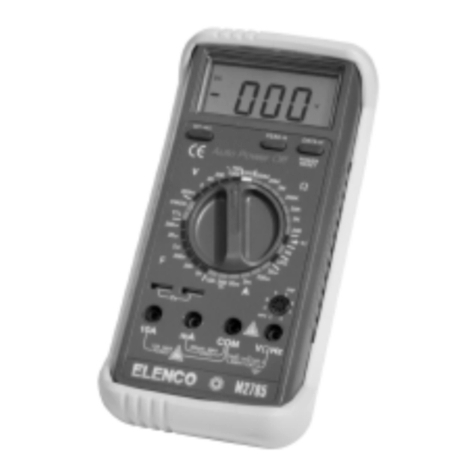
Elenco Electronics
Elenco Electronics M-2785 Operator's instruction manual
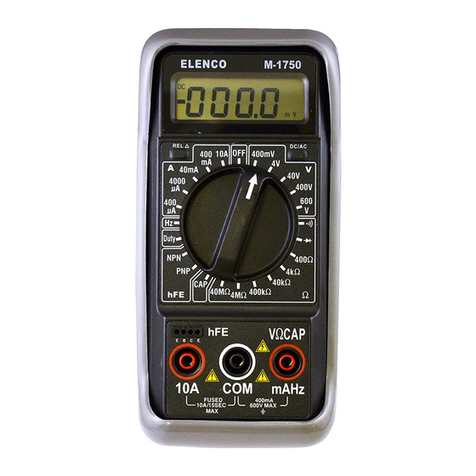
Elenco Electronics
Elenco Electronics M-1750 Operator's instruction manual

gefran
gefran 556 quick start guide
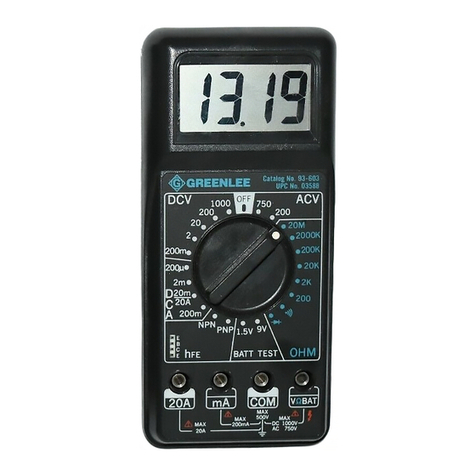
Greenlee
Greenlee 93-603 Operating, maintenance and safety instructions
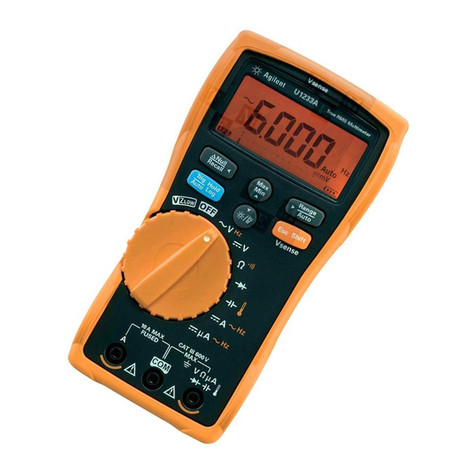
Keysight
Keysight U1231A quick start guide
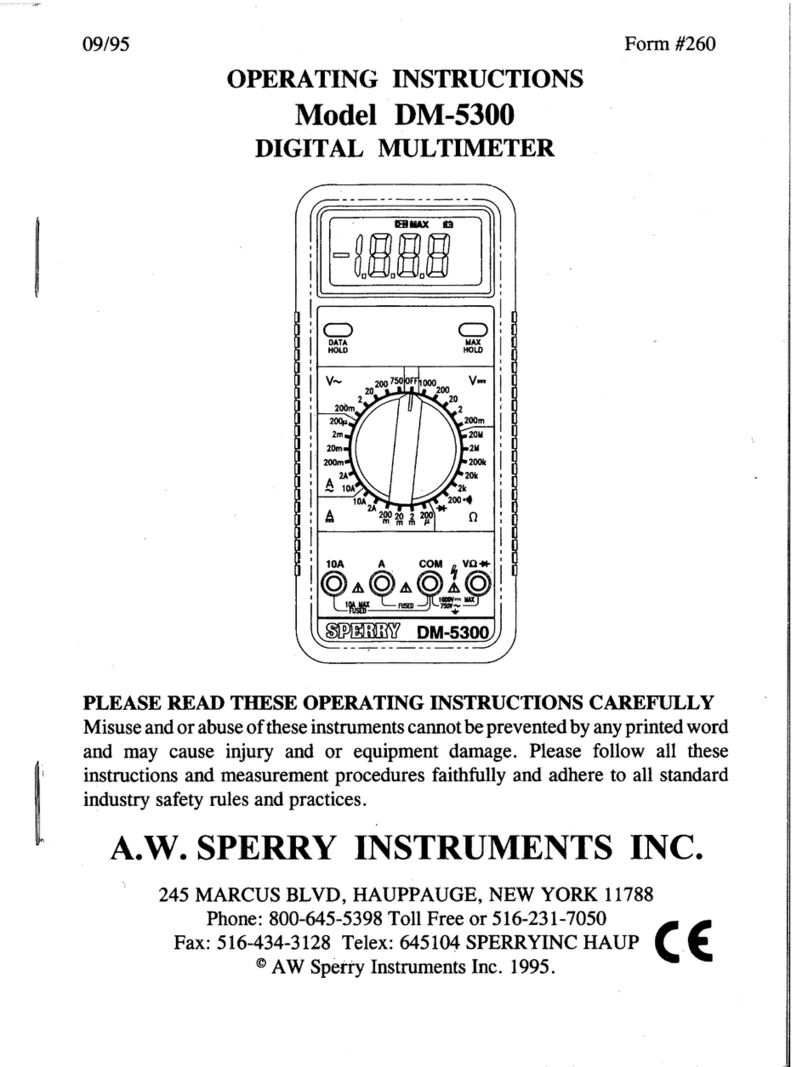
Sperry instrument
Sperry instrument DM-5300 operating instructions

